Opae Ula Shrimp, also known as Hawaiian red shrimp, are a small species of shrimp that are native to Hawaii.
These small shrimp can live as long as 15 years they are a popular choice for shrimp aquarium enthusiasts due to their unique appearance, low-maintenance care, and ability to thrive in a variety of tank conditions.
Studying and understanding Opae Ula Shrimp is important for several reasons. First, they play an important role in their natural ecosystems and provide valuable benefits to their habitats. They help to control algae growth and serve as a food source for larger predators, which helps to maintain a healthy balance in their ecosystems.
In addition, understanding the behavior and biology of Opae Ula Shrimp can provide important insights into the larger field of crustacean biology and aquatic ecosystems. They are also used as model organisms in scientific research, particularly in areas such as developmental biology and genetics.
They are very hardy and can tolerate a wide range of water conditions, making them a great choice for beginner aquarists or those looking for low-maintenance pets. They also have a unique appearance and behavior, with their bright red color and tendency to gather in large groups.
Opae Ula Shrimp are also a great choice for those who want to create a self-sustaining ecosystem in their aquarium. They can survive on a variety of food sources, including algae and other microorganisms that naturally occur in the tank. This means that they can often thrive without the need for supplemental feeding or filtration systems.
Overall, Opae Ula Shrimp are fascinating creatures that provide important benefits to their ecosystems and can be a great addition to any aquarium. By studying and understanding these creatures, we can continue to learn more about crustacean biology and aquatic ecosystems, and ensure that these fascinating creatures continue to thrive in the wild and in captivity.

Description of Opae Ula Shrimp
Opae Ula Shrimp, or Halocaridina rubra, belong to the family Atyidae, which is a family of freshwater shrimp. They are native to the Hawaiian Islands, and are found in brackish water pools, anchialine pools, and lava tubes, as well as other locations with low salinity water.
Opae Ula Shrimp are small in size, typically ranging from 0.5 to 1.5 cm in length. They have a bright red coloration, which is believed to be a result of their adaptation to living in lava tubes with limited light. They have a flattened body shape and are relatively transparent, allowing their internal organs to be seen through their exoskeleton.
In terms of physical characteristics, Opae Ula Shrimp have a unique respiratory system that allows them to absorb oxygen through their gills, as well as through their legs and antennae. They also have two pairs of claws, with the first pair being significantly larger than the second pair. These claws are used for both feeding and defense against predators.
Opae Ula Shrimp are also known as super shrimp for their ability to adapt to a wide range of environmental conditions. They can tolerate fluctuations in temperature, salinity, and oxygen levels, which allows them to survive in harsh conditions that many other aquatic creatures would not be able to withstand.
In the wild, Opae Ula Shrimp are found in a variety of locations, including pools near the shoreline, caves, and lava tubes. These pools are often characterized by low salinity levels and high levels of volcanic ash and minerals. The shrimp feed on a variety of small organisms, such as algae, bacteria, and detritus.
Opae Ula Shrimp are unique creatures with several interesting physical and behavioral characteristics. Their ability to adapt to a wide range of conditions and their importance in their natural ecosystems make them important species to study and understand.
Why Are Opae Ula Shrimp Eyes So Small
Opae ula shrimp have relatively small eyes compared to other shrimp species, which is likely due to their adaptation to their unique habitat.
Opae ula are native to the Hawaiian Islands and are commonly found in brackish water pools, lava tubes, and anchialine ponds. These environments are typically dark, with limited light penetration, and the shrimp have evolved to adapt to these low-light conditions.
In low-light environments, having larger eyes does not necessarily provide an advantage as it can actually make it more difficult to focus on objects. Instead, Opae ula have small, simple eyes that are designed to detect movement and light changes. This allows them to quickly respond to predators or other potential threats in their environment.
In addition, Opae ula shrimp are scavengers and feed on detritus, algae, and other small organisms that are found in their environment. Their small eyes are also well-suited for locating and detecting these small food sources.
the small size of Opae ula shrimp’s eyes is a result of their adaptation to their dark, low-light environment and their feeding habits. While their vision may not be as acute as some other shrimp species, their other adaptations have allowed them to thrive in their unique habitat.
Life cycle and behavior of Opae Ula Shrimp
Opae Ula Shrimp have a unique life cycle and behavior, which includes reproduction, development, feeding, and social interactions.
Reproduction and Development: Opae Ula Shrimp reach maturity at around six months of age and are capable of reproducing throughout the year. The female shrimp then carries the fertilized eggs in a pouch underneath her abdomen until they hatch.
in a pouch underneath her abdomen until they hatch.
The eggs hatch into larvae, which are planktonic and spend several weeks in the water column before settling on the substrate. After settling, the larvae undergo metamorphosis and develop into juvenile shrimp. The juveniles have a similar appearance to adult shrimp, but are smaller in size and lack the distinctive large claws of mature individuals.
Feeding and Diet: Opae Ula Shrimp are primarily scavengers, feeding on detritus, algae, and other small organisms that they can find in their environment. They also have the ability to filter feed, using their small appendages to collect and filter out small particles from the water column.
In aquarium settings, Opae Ula Shrimp can be fed a variety of foods, including commercial shrimp pellets, algae wafers, and vegetable matter. It is important to avoid overfeeding, as excess food can contribute to poor water quality and harm the shrimp.
Social Behavior and Interactions: Opae Ula Shrimp are social creatures and are often found in large groups in the wild. They do not have a strict hierarchy.
In aquarium settings, it is important to provide ample hiding places and space for the shrimp to establish territories and explore their environment. They may also interact with other species in the aquarium, such as snails and other shrimp species, depending on the specific tank setup.
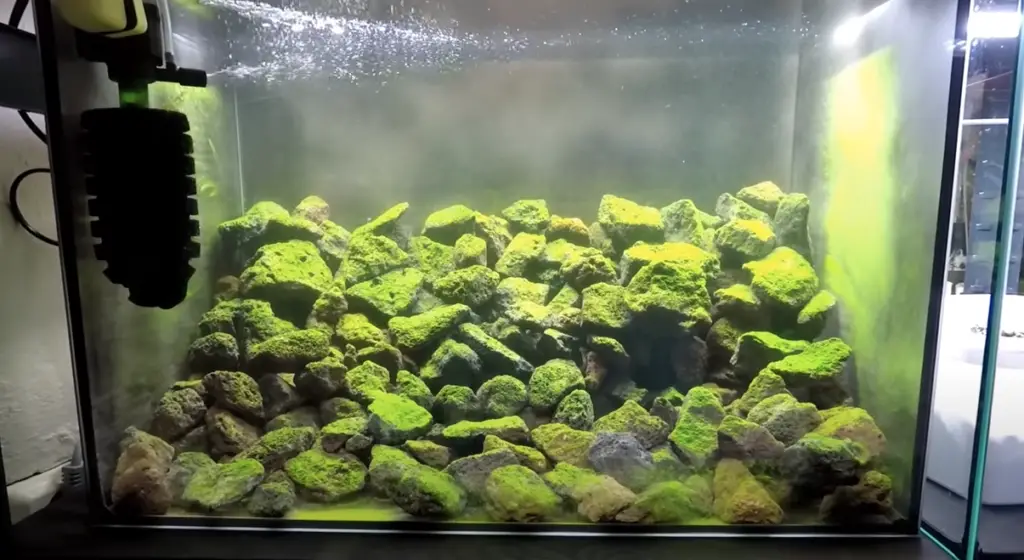
Shrimp Tank parameters for keeping Opae Ula Shrimp
When keeping Opae Ula Shrimp in an aquarium, it is important to provide the right tank parameters to ensure their health and well-being. This includes the tank size and setup, water parameters, and substrate and decor.
in an aquarium, it is important to provide the right tank parameters to ensure their health and well-being. This includes the tank size and setup, water parameters, and substrate and decor.
Tank Size and Setup: Opae Ula Shrimp are relatively small in size, and can be kept in small aquariums or even in a jar or vase. However, a larger tank will provide more space for the shrimp to move around and establish territories. A minimum tank size of 2.5 gallons is recommended to provide ample space for a small group of shrimp.
Filtration: This shrimp is special in that it has evolved to live in very harsh rockpool-type conditions so it doesn’t need to have a filter in the tank however I find having a small sponge filter in the tank useful to stop the water going stagnant.
The tank setup should include hiding places and ample surface area for the shrimp to explore and feed. This can include live rock or artificial decor, such as PVC pipes or ceramic pots. It is also important to provide a lid or cover to prevent the shrimp from escaping the tank.
the tank.
I like to use ample amounts of lava rock and coral in my tanks.
Water Parameters: Opae Ula Shrimp are able to tolerate a wide range of water conditions, but it is important to maintain stable water parameters to prevent stress and disease.
| Parameter | Range |
|---|---|
| Temperature | 22-28°C (72-82°F) |
| Salinity | 1.010-1.025 specific gravity |
| pH | 7.8-8.4 |
| Ammonia | 0 ppm |
| Nitrite | 0 ppm |
| Nitrate | <20 ppm |
| Dissolved Oxygen | >6 ppm |
| Alkalinity | 120-180 ppm as CaCO3 |
| Calcium | 380-450 ppm |
| Magnesium | 1250-1350 ppm |
It’s worth noting that Opae ula are a relatively hardy species and can tolerate a range of conditions, but these parameters are generally considered optimal for their health and wellbeing.
I use 30 grams of instant ocean per liter of pure reverse osmosis water to make the water for the shrimp, having a refractometer is also very handy.
I also use a small heater in this tank to keep the water at a constant 24c
It is important to monitor these parameters regularly using a water test kit , and make adjustments as needed.
, and make adjustments as needed.
Substrate and Decor: Opae Ula Shrimp prefer a substrate that is made of natural materials, such as sand or crushed coral. This provides a natural environment for the shrimp and helps to maintain stable water parameters.
In terms of decor, it is essential to provide ample hiding places and surface areas for the shrimp to explore and feed. This can include live rock or artificial decors, such as PVC pipes or ceramic pots.
In terms of tank mates I keep Nerite snails and MTS snails both are placed in a vessel containing the water they live in, you add that container to the opea ula tank, and every few days add a little salt water to the floating container, and eventually the snails will make there ways out of the container and be fully acclimated to brackish water.
snails and MTS snails both are placed in a vessel containing the water they live in, you add that container to the opea ula tank, and every few days add a little salt water to the floating container, and eventually the snails will make there ways out of the container and be fully acclimated to brackish water.
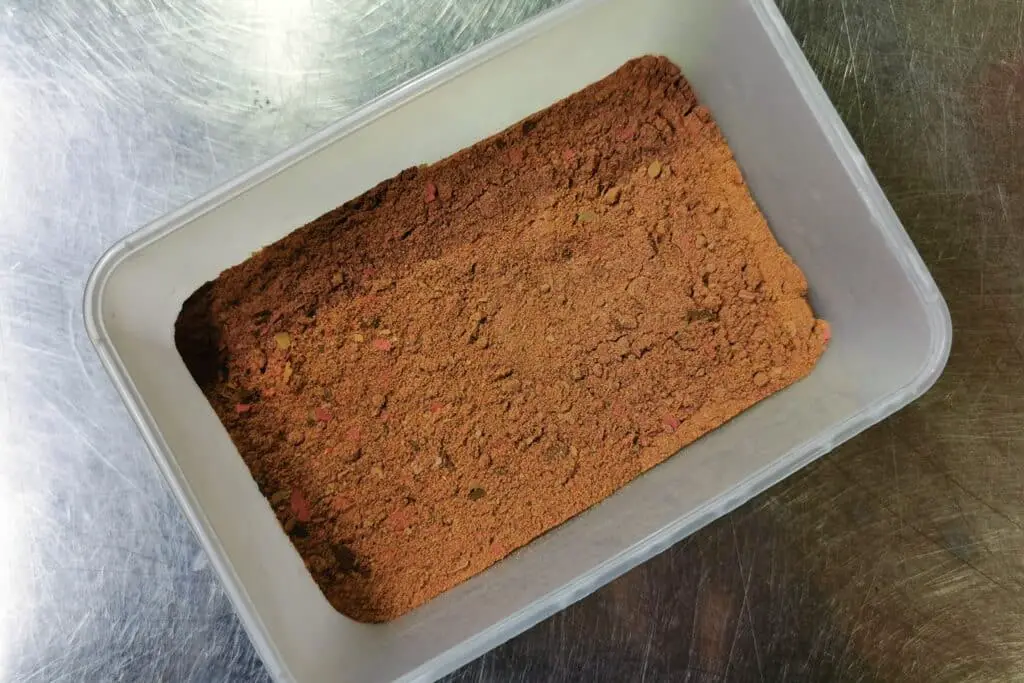
Feeding Opae Ula Shrimp
Opae Ula Shrimp are primarily scavengers and will feed on detritus, algae, and other small organisms in their natural environment. In an aquarium, they can be fed a variety of foods to supplement their natural diet.
Natural Diet of Opae Ula Shrimp: Opae Ula Shrimp are able to feed on a variety of small organisms, including algae, bacteria, and detritus. In their natural environment, they will scavenge for food by filtering the water and picking at surfaces to collect small particles.
Supplemental Feeding for Aquariums: In an aquarium setting, Opae Ula Shrimp can be fed a variety of foods to supplement their natural diet. This can include commercial shrimp pellets, algae wafers, and vegetable matter. It is important to avoid overfeeding, as excess food can contribute to poor water quality and harm the shrimp.
It is also important to provide a varied diet to ensure that the shrimp receive all of the necessary nutrients. This can include a combination of commercially available foods, as well as live or frozen foods such as brine shrimp or daphnia.
How Often to Feed: Opae Ula Shrimp have a slow metabolism and do not require daily feedings. In fact, overfeeding can contribute to poor water quality and harm the shrimp.
It is recommended to feed Opae Ula Shrimp once every 2-3 days, or even less frequently depending on the size of the tank and the number of shrimp present. It is important to monitor the water quality and adjust feeding frequency as needed to maintain stable water conditions.
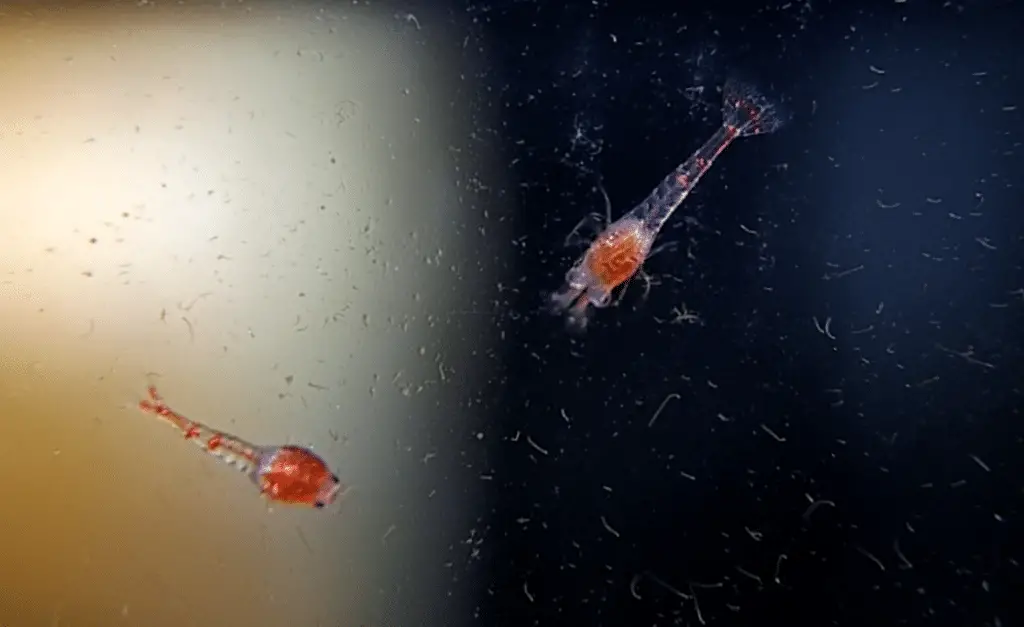
Breeding Opae Ula Shrimp
Opae Ula Shrimp do not have a specific mating ritual or courtship behavior. Instead, reproduction is typically initiated by a female releasing pheromones to attract a male. The male will then approach the female and deposit sperm packets on her body, which she will use to fertilize her eggs.
Rearing Larvae and Juveniles: Once the eggs are fertilized, the female shrimp will carry them in a pouch underneath her abdomen until they hatch. The larvae are planktonic and spend several weeks in the water column before settling on the substrate. After settling, the larvae undergo metamorphosis and develop into juvenile shrimp.
Challenges and Considerations for Breeding: Breeding Opae Ula Shrimp can be challenging due to their slow growth and low reproductive rate. In addition, their sensitivity to water conditions means that even slight changes in temperature, salinity, or pH can impact their reproductive success.
To improve the chances of successful breeding, it is important to maintain stable water conditions and provide a healthy and varied diet for the shrimp. It may also be helpful to provide ample hiding places and space for the shrimp to establish territories and explore their environment.
Care and maintenance of Opae Ula Shrimp
Opae Ula Shrimp are hardy creatures that are relatively low-maintenance and can thrive in a simple, low-tech aquarium. However, it is still important to provide proper care and maintenance to ensure their health and well-being. Here are some key considerations for caring for Opae Ula Shrimp:
Water Maintenance: Opae Ula Shrimp do not require water changes, as they are capable of thriving in a closed ecosystem. All that is needed is to top up the water periodically to replace any that has evaporated. It is still important to monitor water parameters regularly, including salinity, pH, temperature, and ammonia and nitrite levels, and make adjustments as needed to maintain stable conditions.
Feeding and Diet: Opae Ula Shrimp have a scavenging feeding behavior and can survive on a variety of food sources in the aquarium, including algae, bacteria, and detritus. However, it is important to provide a varied and nutritious diet to ensure their health and well-being. Commercially available shrimp pellets, algae wafers, and vegetable matter can all be used to supplement their diet. It is important to avoid overfeeding, as excess food can contribute to poor water quality and harm the shrimp.
Tank Size and Setup: Opae Ula Shrimp are relatively small in size and can be kept in small aquariums or even in a jar or vase. However, a larger tank will provide more space for the shrimp to move around and establish territories. The tank setup should include hiding places and ample surface area for the shrimp to explore and feed. Live rock or artificial decor, such as PVC pipes or ceramic pots, can provide hiding places and surface area.
Common Diseases and Health Issues: Opae Ula Shrimp are generally hardy and resistant to disease, but they can still be affected by health issues such as fungal infections, bacterial infections, and parasites. Symptoms of disease in Opae Ula Shrimp can include lethargy, loss of appetite, discoloration, and abnormal behavior. If you suspect that your shrimp may be sick, it is important to isolate them and seek veterinary advice.

Can Opae Ula live in freshwater?
Opae ula, also known as Hawaiian red shrimp, are typically found in brackish water habitats that are a mixture of saltwater and freshwater. While they can tolerate a range of salinity levels, they are not adapted to live in pure freshwater environments.
In their natural habitat, Opae ula are found in tide pools, anchialine ponds, and lava tubes in Hawaii, where the water is typically a mix of seawater and freshwater. They are able to adapt to different salinity levels by regulating the concentration of salts in their bodies, but they require at least some salt in their environment to survive.
Therefore, it is not recommended to keep Opae ula in freshwater aquariums, as it may harm or even kill them. They are best kept in brackish water aquariums with the appropriate salinity levels and other environmental conditions that mimic their natural habitat.
Nicknames and cultural significance of Opae Ula Shrimp
Opae Ula Shrimp are known by various nicknames and have significant cultural and economic importance in certain regions. Here are some of the common nicknames and cultural significance of Opae Ula Shrimp:
Different Nicknames: Opae Ula Shrimp are known by various nicknames in different parts of the world. Some of the common nicknames include Hawaiian red shrimp, Volcano shrimp, Hawaiian opae, and micro lobster.
Cultural and Economic Significance: Opae Ula Shrimp have significant cultural and economic importance in Hawaii and other regions where they are found. In Hawaii, they are considered to be a symbol of good luck and are often used in traditional Hawaiian ceremonies and rituals. They also have culinary significance and are used in a popular Hawaiian dish known as poke.
Opae Ula Shrimp are also used in the aquarium trade, and are popular among hobbyists due to their hardiness and unique appearance. In addition, they are used in research by scientists, including NASA, to study the effects of space travel on living organisms.
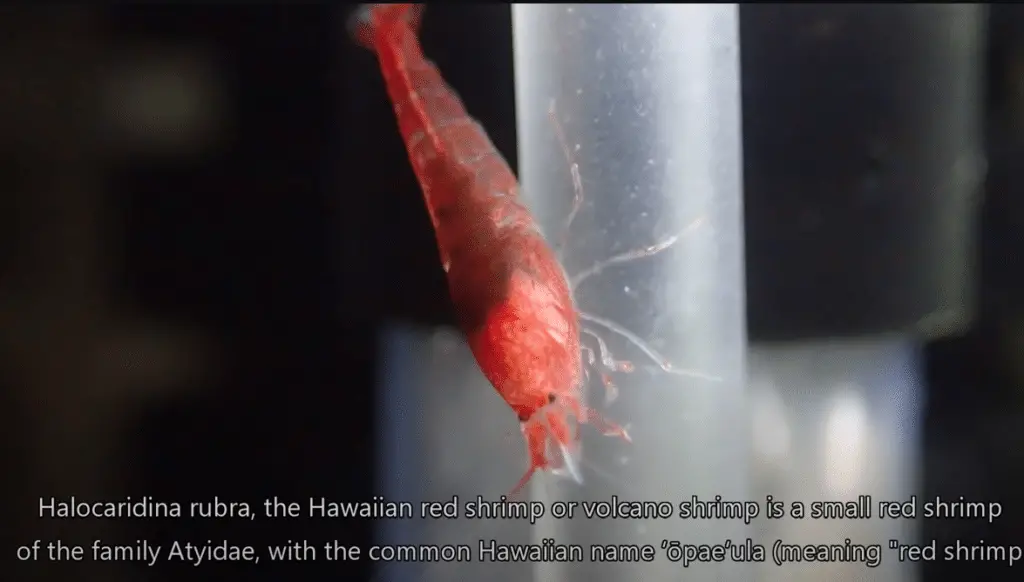

Chaetomorpha Macroalgae
Chaetomorpha is a genus of green macroalgae that is commonly used in marine aquariums as a natural filter to control nutrient levels. This type of algae is highly adaptable and can grow in a wide range of environments. In fact, Chaetomorpha is thriving in my Opae Ula tank, and I have found that it responds well to high levels of light.
One of the key characteristics of Chaetomorpha is its ability to absorb large amounts of nutrients such as nitrates and phosphates, which are essential for the growth of other organisms in the aquarium. This makes it an excellent choice for maintaining a healthy and balanced ecosystem, especially in reef tanks where corals and other sensitive animals thrive.
Another notable feature of Chaetomorpha is its fast growth rate, which allows it to quickly fill up space in the aquarium and outcompete other types of algae. This is particularly advantageous in tanks where unwanted algae growth is a problem, as Chaetomorpha can help to reduce and eliminate these issues. In terms of care, Chaetomorpha is generally easy to maintain and can be propagated by simply dividing the algae into smaller sections and replanting them in the tank. Overall, Chaetomorpha is a beneficial addition to any marine aquarium and is an excellent choice for those looking to promote a healthy and thriving aquatic ecosystem.

Natural Debris In Opae Ula Water Pools
Opae Ula shrimp are known to inhabit small pools that are often located near the coast. These pools are subject to debris falling into them, such as dead animals like small birds and crabs. Additionally, driftwood can make its way into these pools from the ocean, or from nearby trees. The pools can also have leaf litter in them from native plants. Some aquarium enthusiasts, like myself, prefer to add dried almond leaves and walnut leaves to these pools as well. However, it is important to let any wood or leaves soak for a few days before adding them to the tank, to ensure that any harmful chemicals or substances are leached out.
in them from native plants. Some aquarium enthusiasts, like myself, prefer to add dried almond leaves and walnut leaves to these pools as well. However, it is important to let any wood or leaves soak for a few days before adding them to the tank, to ensure that any harmful chemicals or substances are leached out.
Despite the presence of debris, the Opae Ula shrimp are well adapted to thrive in such an environment. The shrimp feed on biofilm, which is a thin layer of bacteria and other microorganisms that form on the surfaces of rocks, wood, and other objects in the pool. This biofilm provides the shrimp with all the necessary nutrients they need to survive. In fact, the presence of debris and leaf litter in the pool can even be beneficial, as they can provide additional sources of nutrition for the shrimp.
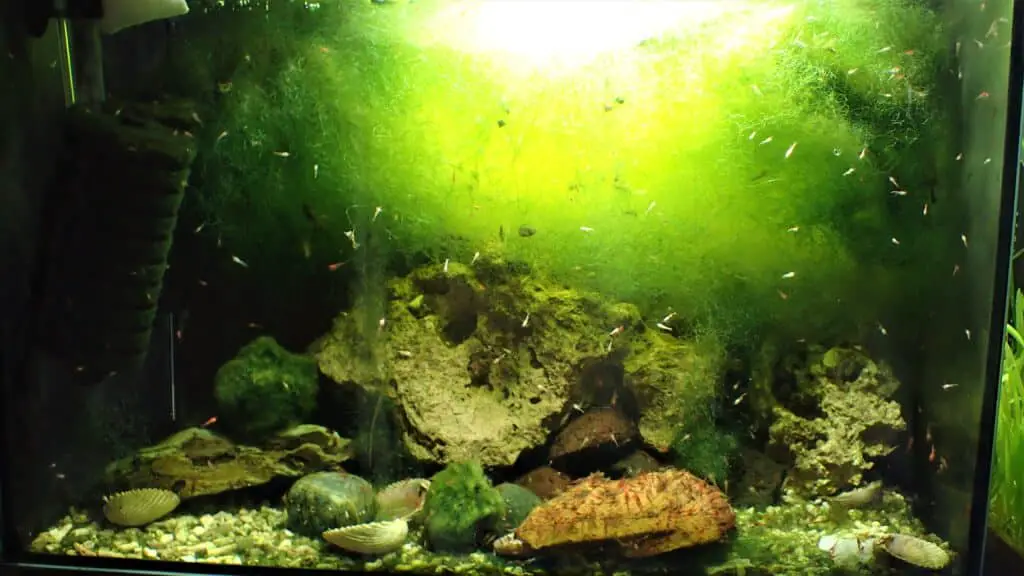
Biofilm
Biofilm plays a crucial role in the diet of Opae Ula shrimp. Biofilm is a thin layer of bacteria and other microorganisms that forms on the surfaces of rocks, wood, and other objects in the pool. This biofilm provides the shrimp with all the necessary nutrients they need to survive. In fact, it is estimated that up to 90% of their diet comes from biofilm. Therefore, it is important to maintain a healthy and thriving biofilm in the tank.
To promote the growth of biofilm in the tank, I use a product called Bacter AE. This product contains a blend of microorganisms and nutrients that help to promote the growth of biofilm in the tank. However, it is important to use this product in moderation and at a low dose, as overfeeding can lead to the growth of harmful bacteria and other issues. In my experience, I have found that using half the recommended dose of Bacter AE is sufficient to maintain a healthy biofilm in the tank without causing any issues.
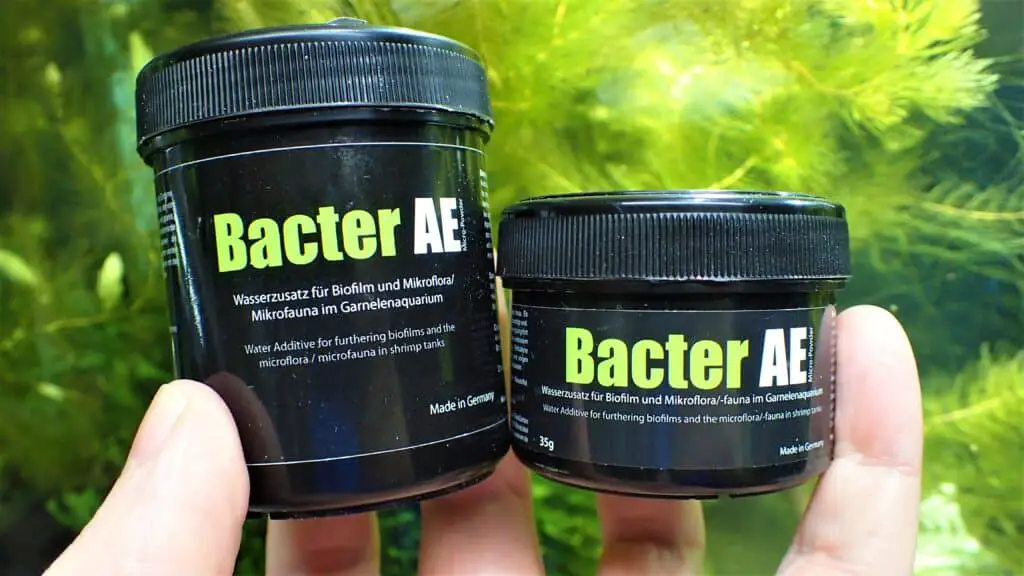
Opae Ula Tank Mates
Nerite Snails:
Nerite Snails are a fantastic addition to an Opae Ula tank, as they are hardworking algae-eaters that help keep your tank clean. To introduce Nerite Snails to your shrimp habitat, begin by placing them in a cup of freshwater floating in the tank. Over time, the Nerite Snails will gradually acclimate themselves to the brackish water conditions. This process allows the snails to adjust to the tank’s specific water parameters, ensuring a smooth transition and minimizing stress.
Malaysian Trumpet Snails:
Malaysian Trumpet Snails are another excellent tank mate for Opae Ula, as they contribute to maintaining the tank’s substrate and helping to prevent harmful gas build-up. These snails burrow into the substrate, which promotes oxygen exchange and keeps the tank’s environment healthy for all its inhabitants. To introduce Malaysian Trumpet Snails, you’ll want to use the drip acclimation method. This process involves gradually mixing the tank’s water with the water the snails are currently in, over the course of 3 days. This slow adjustment helps the snails acclimate to the specific water parameters of your Opae Ula tank, ensuring a successful integration.
are another excellent tank mate for Opae Ula, as they contribute to maintaining the tank’s substrate and helping to prevent harmful gas build-up. These snails burrow into the substrate, which promotes oxygen exchange and keeps the tank’s environment healthy for all its inhabitants. To introduce Malaysian Trumpet Snails, you’ll want to use the drip acclimation method. This process involves gradually mixing the tank’s water with the water the snails are currently in, over the course of 3 days. This slow adjustment helps the snails acclimate to the specific water parameters of your Opae Ula tank, ensuring a successful integration.
Benefits of Nerite and Malaysian Trumpet Snails in an Opae Ula Tank Shrimp Aquarium:
- Algae control: Both Nerite and Malaysian Trumpet Snails are efficient algae-eaters, contributing to a clean and healthy tank environment.
- Substrate maintenance: Malaysian Trumpet Snails aerate the substrate through their burrowing habits, preventing the build-up of harmful gases.
- Peaceful coexistence: Both snail species are non-aggressive and will not harm your Opae Ula shrimp.
- Low bioload: These snails have a minimal impact on the tank’s bioload, meaning they won’t significantly affect the water quality or require additional filtration.
- Aesthetics: The presence of Nerite and Malaysian Trumpet Snails adds another layer of diversity to your tank, making it an even more captivating aquatic display.
The Natural Habitat of Opae Ula Shrimp Anchialine Rock Pools Hawaii

Where is Opae Ula found?
The Opae Ula shrimp (Halocaridina rubra) is a fascinating and resilient species that thrives in the unique ecosystems of anchialine rock pools, found primarily in the Hawaiian Islands. These pools are landlocked bodies of water that have no direct connection to the ocean but are influenced by its tides. They are characterized by a mix of fresh and saltwater, resulting from the percolation of rainwater through porous lava rock and the influx of underground seawater. The unique combination of geological and hydrological factors in these habitats has allowed the Opae Ula shrimp to develop remarkable adaptations to survive in such harsh environments.
The Hawaiian Islands: A Hotspot for Anchialine Rock Pools
The Hawaiian Islands are volcanic in origin, which makes them an ideal location for anchialine rock pools to form. The porous nature of lava rock allows seawater to seep into the pools, creating a brackish environment that supports the life of Opae Ula shrimp. These pools are often found along the coastal regions, with the Big Island of Hawaii and the islands of Maui, Oahu, and Kauai having the highest concentrations.
A Dynamic Environment: Fluctuating Salinity and Nutrient Availability
The Opae Ula shrimp have adapted to the challenging conditions found in anchialine rock pools. The pools’ salinity can range from nearly freshwater to almost three times the salt content of seawater, fluctuating with tidal movements and rainfall.
This ever-changing environment has led to the shrimp developing a high tolerance for varying salinity levels. Additionally, the pools can experience temperature fluctuations, low oxygen levels, and variable nutrient availability. The Opae Ula shrimp have evolved to withstand these extreme conditions and thrive in their unique habitat.
Feeding and Adaptations: The Opae Ula Shrimp’s Resilience
The Opae Ula shrimp have a specialized feeding strategy that allows them to survive in their nutrient-poor environment. These omnivorous crustaceans primarily feed on microorganisms such as algae, bacteria, and detritus that are present in the anchialine rock pools. Their ability to consume a variety of food sources is key to their survival, as the availability of nutrients can vary greatly.
One of the most striking adaptations of the Opae Ula shrimp is their vibrant red coloration. This is due to the presence of carotenoid pigments in their bodies, which serve as an antioxidant and protect the shrimp from the harmful effects of UV radiation. The high levels of sunlight exposure in the shallow rock pools make this adaptation crucial for the shrimp’s survival.
Conservation Efforts: Preserving the Opae Ula Shrimp’s Habitat
The anchialine rock pools of Hawaii are fragile ecosystems that face various threats, including coastal development, pollution, and invasive species. The conservation of these unique habitats is essential to preserve the endemic species they support, including the Opae Ula shrimp. Local and state agencies, together with community organizations, are working on habitat restoration projects and implementing protective measures to ensure the long-term survival of the Opae Ula shrimp and the unique ecosystem they inhabit.
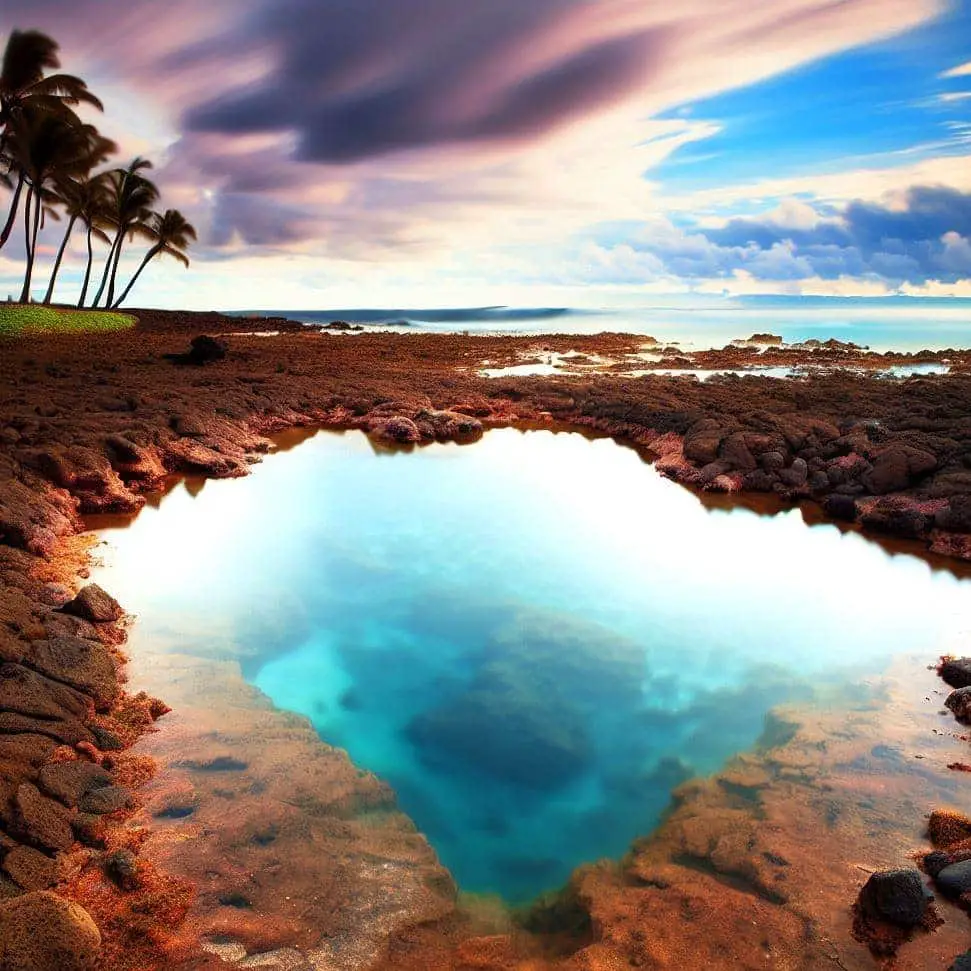
Where can I buy opae ula?
The Importance of Ethical Purchasing
The Opae Ula shrimp has gained popularity as a unique addition to home and office aquariums due to their vibrant color, low maintenance requirements, and fascinating behavior. However, as the demand for these captivating creatures grows, it is crucial to make ethical and informed decisions when purchasing them. By choosing to buy from responsible breeders rather than those who collect shrimp from the wild, you can help support conservation efforts and ensure the long-term survival of Opae Ula shrimp in their natural habitats.
The Role of Responsible Breeders
Sustainable and responsible breeders play a significant role in preserving the populations of Opae Ula shrimp in the wild. By maintaining a controlled breeding environment, they can ensure a continuous supply of healthy, captive-bred shrimp for the aquarium trade without negatively impacting wild populations. These breeders often have extensive knowledge about the shrimp’s biology, habitat, and care requirements, ensuring that the Opae Ula shrimp they provide are well-suited for life in captivity.
Supporting Sustainable Breeders: Benefits and Considerations
There are several advantages to purchasing Opae Ula shrimp from responsible breeders, including:
- Conservation: By choosing captive-bred shrimp, you are helping to reduce the pressure on wild populations and supporting the conservation of their natural habitats.
- Health and Adaptability: Captive-bred Opae Ula shrimp are typically healthier and
- more adaptable to aquarium conditions, as they have been bred and raised in a controlled environment that mimics their natural habitat. This can result in a higher survival rate and less stress for the shrimp when introduced to a new tank.
- Genetic Diversity: Responsible breeders prioritize maintaining genetic diversity within their captive populations, which contributes to the overall health and resilience of the shrimp. This can help prevent issues related to inbreeding and ensure the long-term viability of captive Opae Ula shrimp populations.
- Expert Advice: Purchasing from a knowledgeable breeder provides the opportunity to receive expert advice on the care and maintenance of your Opae Ula shrimp. This can lead to a more successful and rewarding experience for both you and your shrimp.
Avoiding Wild Collection: The Impact on Natural Habitats
Collecting Opae Ula shrimp from the wild can have serious consequences for the delicate anchialine rock pool ecosystems in Hawaii. Removing shrimp from these habitats can disrupt the balance of the ecosystem, which may lead to long-lasting negative effects on the overall health and biodiversity of the rock pools. Additionally, wild-caught shrimp may not adapt well to life in captivity, as they are not accustomed to the conditions of an aquarium, resulting in increased stress and lower survival rates .
.
Making a Difference with Your Purchase
By choosing to buy Opae Ula shrimp from sustainable breeders, you can make a significant contribution to the conservation of these unique creatures and their natural habitats. Your decision not only supports the preservation of anchialine rock pools but also promotes responsible practices within the aquarium trade.
Remember to research breeders, ask questions about their practices, and select those who prioritize the health and well-being of the Opae Ula shrimp and their ecosystems.

Dont Buy Opae Ula Shrimp Ecosphere
Ecospheres are small, self-contained ecosystems that are designed to be low-maintenance and self-sustaining. They typically consist of a sealed glass or acrylic sphere that contains live plants, animals, and microorganisms. While they can be fascinating to observe and provide a glimpse into the natural world, they are not an ideal environment for shrimp.
One of the main problems with ecospheres is that they are generally too small to support a healthy population of shrimp. Shrimp require a certain amount of space to move around and find food, and the limited volume of water in an ecosphere can quickly become overcrowded and polluted. This can lead to a build-up of ammonia and other harmful compounds, which can stress or even kill the shrimp.
In addition, ecospheres are often marketed as being low-maintenance, but in reality, they require a significant amount of care and attention to keep them healthy. Without regular water changes and monitoring, the water quality in an ecosphere can quickly degrade, which can have serious consequences for the shrimp.
Finally, it’s worth noting that many ecospheres are marketed as being “self-sustaining”, but this is often not the case. While they may contain live plants and microorganisms that can produce oxygen and remove waste, they are not capable of providing all the nutrients and resources that shrimp need to thrive. In order to maintain a healthy population of shrimp, it’s important to provide them with a balanced diet and a suitable environment that meets their specific needs.
While ecospheres can be a fun and interesting way to explore the natural world, they are not a suitable environment for shrimp. If you want to keep shrimp as pets, it’s best to provide them with a properly-sized aquarium that allows them to move around and find food, and to regularly monitor and maintain the water quality to ensure their health and wellbeing.

Conclusion
Opae Ula Shrimp are a fascinating and unique species that have captured the attention of aquarium enthusiasts, scientists, and cultural groups alike. They are hardy creatures that are relatively easy to care for in an aquarium, but also have significant cultural and economic importance in certain regions.
Opae Ula Shrimp have also proven to be a valuable model organism for space research, due to their adaptability and hardiness. They have been used in numerous space experiments to understand the effects of microgravity and radiation on living organisms.
However, the natural habitats of Opae Ula Shrimp are increasingly threatened by human activities, and conservation efforts are needed to protect them. By understanding the threats to their natural habitats and supporting conservation efforts, we can help to protect these unique creatures for future generations.
Opae Ula Shrimp are a fascinating and important species that offer insights into biology, culture, and space research. Whether in an aquarium or in the wild, these unique creatures have much to offer and much to teach us about the natural world.
FAQ Opae Ula
Q: Can opae ula live in freshwater? A: No, Opae Ula are brackish water shrimp and cannot survive in freshwater environments. They require a mix of fresh and saltwater to thrive.
Q: Where is Opae Ula found? A: Opae Ula are native to Hawaii, where they can be found in anchialine pools, which are landlocked bodies of water with a subterranean connection to the ocean.
Q: How long do opae ula shrimp live for? A: Opae Ula can live for up to 20 years, making them one of the longest-living shrimp species in the aquarium hobby.
Q: Are opae ula shrimp edible? A: Opae Ula are not considered a food source and are not commonly consumed by humans.
Q: Do you need to feed opae ula? A: Opae Ula can survive on the algae that grow in their tank. However, supplementary feeding with spirulina or other algae-based foods can be beneficial, especially in a new or sparsely populated tank.
Q: What does opae mean in Hawaiian? A: Opae means “shrimp” in the Hawaiian language.
Q: Is opae-ula saltwater? A: Opae Ula are not purely saltwater shrimp; they inhabit brackish water environments, which are a mix of fresh and saltwater.
Q: Can opae-ula live in saltwater? A: Opae Ula can tolerate a wide range of salinities, but they thrive best in brackish water. Although they can survive in saltwater for a short period, it is not recommended as a long-term habitat.
Q: Do opae ula need oxygen? A: Yes, Opae Ula need oxygen to survive. However, they can tolerate low oxygen levels better than most aquatic species. A well-maintained tank with proper filtration and water circulation should provide sufficient oxygen for them.
Q: Why is my opae ula white? A: Opae Ula may turn white due to stress, molting, or illness. If other tank conditions are optimal, the shrimp should regain their color over time.
Q: What does algae get from opae? A: Algae benefit from the presence of Opae Ula, as the shrimp produce waste, which acts as a nutrient source for the algae’s growth.
Q: How do you grow algae for opae Ula? A: To grow algae for Opae Ula, provide ample light and maintain stable water conditions in your tank. The shrimp will graze on naturally growing algae. You can also introduce live algae or add algae-based food as a supplement.
Q: What is the best substrate for opae ula? A: The best substrate for Opae Ula is a mix of sand and crushed coral. This combination helps maintain proper pH levels and provides an ideal environment for the shrimp.
Q: What is the maximum size of opae ula? A: Opae Ula can grow up to 0.5 inches (1.3 cm) in length, making them one of the smaller shrimp species.
Q: Can shrimp live near a volcano? A: Some shrimp species, like Opae Ula, can live near volcanic regions, as they inhabit anchialine pools in Hawaii, which can be found near volcanic areas. These shrimp are adapted to living in environments with fluctuating conditions and can tolerate a wide range of water parameters.
Q: Are saltwater shrimp hard to keep? A: Some saltwater shrimp species can be challenging to keep, as they require stable water parameters, proper filtration, and a carefully maintained environment. However, with adequate knowledge and attention to detail, maintaining a saltwater shrimp tank can be a rewarding experience.
Q: What is the world’s coolest shrimp? A: This is subjective, but one contender for the “world’s coolest shrimp” title is the Mantis Shrimp, known for its vibrant colors, unique eyesight, and powerful “punch” used to catch prey.
Q: What’s the easiest shrimp to keep? A: The easiest shrimp to keep in a home aquarium are likely the Red Cherry Shrimp (Neocaridina davidi), as they are hardy, adaptable, and can thrive in a variety of water conditions, making them suitable for beginners .
.
